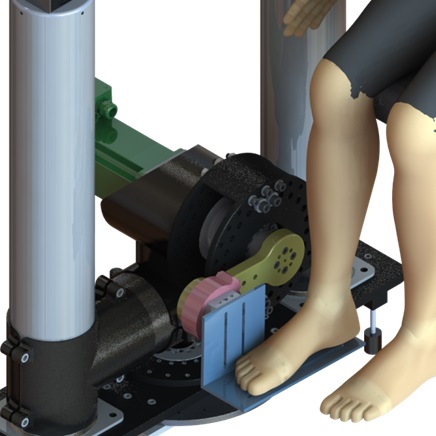Perception of Ankle and Knee Impedance
Motivation
Many assistive technologies, including exoskeletons and powered orthoses, are being developed using engineering principles that closely mimic human biomechanics. Joint impedance (representing the behavior of a joint as a stiffness, damping, and inertia) is often used to describe these biomechanics. We currently don’t know the appropriate joint impedance to use in assistive technologies, and it’s unclear how errors in joint impedance can be sensed by the user. The purpose of this work is to determine how well humans can perceive changes in interaction stiffness and damping with their ankle and knee. The intent of this work is to provide a target for the accuracy required by ankle and knee exoskeletons that actively vary these properties.
Approach
We can quantify the ability to perceive changes in impedance by calculating the “just noticeable difference (JND),” which is the smallest change in stiffness a person can detect. To test this, patients’ right legs are secured to a device called the CBM-Neurobionics Rotary Motor. The patients are then asked to flex either their ankle or knee forward and backward and report whether the machine feels more or less stiff than before. The JND can be calculated by using a method known as the weighted up-down staircase method.
Contributors: Alejandro Azocar, Amanda Shorter, Elliott Rouse
Publications
Azocar, A. F., Shorter, A. L., & Rouse, E. J. (2019). Damping Perception During Active Ankle and Knee Movement. IEEE Transactions on Neural Systems and Rehabilitation Engineering. doi.org/10.1109/TNSRE.2019.2894156
Azocar, A. F., Shorter, A. L., & Rouse, E. J. (2018, July). Perception of Mechanical Impedance During Active Ankle and Knee Movement. In 2018 40th Annual International Conference of the IEEE Engineering in Medicine and Biology Society (EMBC) (pp. 3044-3047). IEEE. doi.org/10.1109/EMBC.2018.8513022
Azocar, A.F. & Rouse, E.J. (2017). Stiffness Perception During Active Ankle and Knee Movement. IEEE Transactions on Biomedical Engineering, 64(12), 2949-2956. doi.org/10.1109/TBME.2017.2691308

